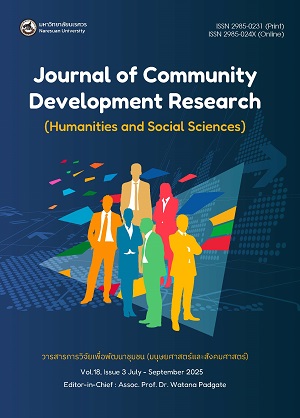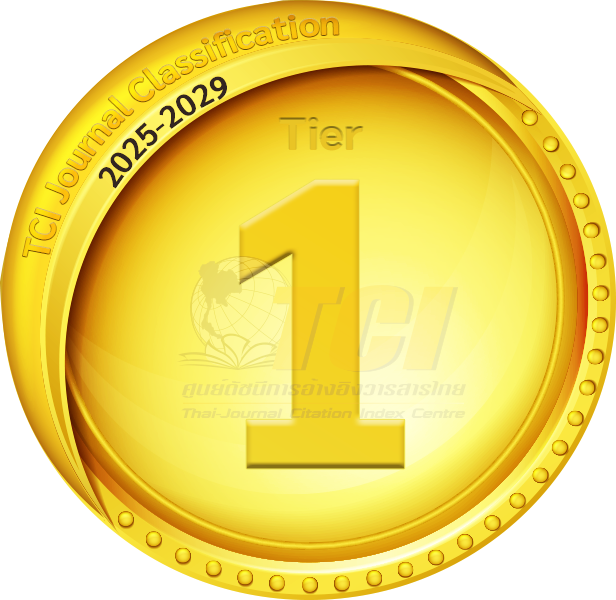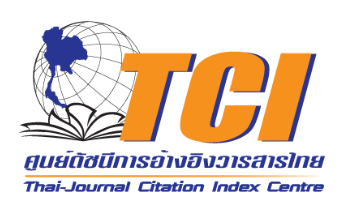Maintaining Ethnic Culture Through Contemporary Museums: The Transformative Journey of the ‘Tai Yuan Samo Khae’ in Phitsanulok, Thailand
DOI:
https://doi.org/10.69650/jcdrhs.2025.916Keywords:
Community Participation, Contemporary Museums, Ethnic Culture, Globalization, MUSEOPEN, Tai Yuan Samo KhaeAbstract
This study examines how the Tai Yuan communities in Samo Khae Subdistrict, Phitsanulok preserves its cultural heritage amid pressures from dominant cultures and globalization. It argues that despite their marginalized status, the Tai Yuan effectively sustain their traditions through adaptive, community-driven initiatives. Employing qualitative methods including in-depth interviews, focus group discussions, participant observation, and participatory approach this study investigates the community’s cultural transformation using the MUSEOPEN framework in contemporary museum settings. The findings indicate that the MUSEOPEN process promotes community engagement and intergenerational collaboration, leveraging both physical and digital platforms for cultural transmission. Digital media empowers the Tai Yuan to assert cultural agency, involve younger generations, and reshape public perceptions of their heritage. The study concludes that cultural resilience in the context of globalization depends not only on preservation, but also on innovation and inclusive community participation.
References
Appadurai, A. (2006). Fear of Small Numbers: An Essay on the Geography of Anger. USA.: Duke University Press.
Barth, F. (1969). Ethnic Groups and Boundaries: The Social Organization of Culture Difference. Boston: Little, Brown and Company.
Browning, Z. (2019). A Comparative Analysis: Legal and Historical Analysis of Protecting Indigenous Cultural Rights Involving Land Disputes in Japan, New Zealand, and Hawai’i. Washington International Law Journal, 28(1), 207–242.
Cabrera, R. M. (2008). Beyond Dust, Memories and Preservation: Roles of Ethnic Museums in Shaping Community Ethnic Identities (Doctoral Dissertation). University of Illinois Chicago, Illinois, Chicago.
Chom Rom Khon Rak Ma Hae. (2024, February 27). The Preservation of Tai Yuan Wooden Horse Club on Ordination Ceremony / Nak Procession Tradition, Klommatan Village. In Facebook [Image]. Retrieved from https://www.facebook.com/photo/?fbid=780890757418301&set=pcb.780893420751368
Cohen, A. (1974). The Lesson of Ethnicity. In A. Cohen (Ed.), Urban Ethnicity. London: Tavistock Publications.
Dutta, U. (2019). Digital Preservation of Indigenous Culture and Narratives from the Global South: In Search of an Approach. Humanities, 8(2), 68. https://doi.org/10.3390/h8020068
Fraser, R. (2020). Cultural Heritage, Ethnic Tourism, and Minority-State Relations Amongst the Orochen in North-East China. International Journal of Heritage Studies, 26(2), 178–200. https://doi.org/10.1080/13527258.2019.1620830
Galluccio, C., & Giambona, F. (2024). Cultural Heritage and Economic Development: Measuring Sustainability Over Time. Socio-Economic Planning Sciences, 95, 101998. https://doi.org/10.1016/j.seps.2024.101998
Gill, R. (2000). Cities and Ethnicity: A Case of De-ethnicization or Re-ethnicization? Sociological Bulletin, 49(2), 211–228. https://doi.org/10.1177/0038022920000203
Goode, G. B. (1889). The Museums of the Future. In Report of the United States National Museum for the Year Ending, June 30, 1889 (pp. 427-445). Retrieved from https://repository.si.edu/handle/10088/29955
Henderson, J. (2003). Ethnic Heritage as a Tourist Attraction: the Peranakans of Singapore. International Journal of Heritage Studies, 9(1), 27–44. https://doi.org/10.1080/1352725022000056613
Hobsbawm, E., & Ranger, T. (Eds.). (1983). The Invention of Tradition. Cambridge: Cambridge University Press. https://doi.org/10.1017/CBO9781107295636
International Council of Museums. (2023). Museums, Sustainability and Wellbeing. Retrieved from https://imd.icom.museum/past-editions/2023-museums-sustainability-and-wellbeing/
Ivy, M. (1995). Discourses of the Vanishing: Modernity, Phantasm, Japan. Chicago: University of Chicago Press.
Johnson, A. (2009). The Museum Educator’s Manual: Educators Share Successful Techniques. Edinburgh: AltaMira Press.
Johnson, M. A., & Carneiro, L. (2014). Communicating Visual Identities on Ethnic Museum Websites. Visual Communication, 13(3), 357–372. https://doi.org/10.1177/1470357214530066
Keyes, C. F. (1995). Who are the Tai? Reflections on the Invention of Local, Ethnic and National Identities. In L. Romanucci-Ross, & G. A. De Vos (Eds.), Ethnic Identity: Creation, Conflict and Accommodation (3th ed., pp. 136–160). Walnut Creek, CA.: AltaMira Press.
Keyes, C. F. (1997). Ethnic Groups, Ethnicity. In T. J. Barfield (Eds.), The Blackwell Dictionary of Anthropology (pp. 152–154). Oxford: Basil Blackwell Publishers.
Lanna Prathet. (2022, March 22). Map Showing the New Settlement and Movement of the Yuan People in Central Thailand. In Facebook [Image]. Retrieved from https://www.facebook.com/105618760947061/photos/a.105693897606214/501859611322972/?type=3
Leepreecha, P. (2013). Multiculturalism from Below: The Movement of the Network of Indigenous Peoples and Ethnic Groups in Thailand. Journal of Social Sciences, Faculty of Social Sciences, Chiang Mai University, 25(2), 59–106. Retrieved from https://so04.tci-thaijo.org/index.php/jss/article/view/172921
Leepreecha, P. (2014). Paradigms of Studies on Ethnicity. Journal of Mekong Societies, 10(3), 219–242. Retrieved from https://so03.tci-thaijo.org/index.php/mekongjournal/article/view/26780
Lin, J. (2010). The Power of Urban Ethnic Places: Cultural Heritage and Community Life. New York: Routledge. https://doi.org/10.4324/9780203843017
Praicharnjit, S. (2007). Archaeological Resource Management in Community Development (3rd ed.). Bangkok: Community Archaeology Book Project.
Praicharnjit, S. (2015). The Nursery Museum and the Sustainable Management of Local Community Cultural Heritage. Journal of Ayutthaya Studies Institute, 7(1), 1–39.
Rapeepat, A., Vaddhanaphuti, C., Pongsapich, A., Chantavanich, S., & Prachuabmoh, C. (2003). Qualitative Research Handbook for Development (4th ed.). Bangkok: Research and Development Institute, Khon Kaen University.
Richards, G. (Ed.). (2007). Cultural Tourism: Global and Local Perspectives. New York: Haworth Hospitality Press.
Sakhajun, C. (2015). Development of Virtual Museum Design: Phutthamonthon Center of World Buddhism. Nakhonprathom: Rajamangala University of Technology Rattanakosin. Retrieved from https://repository.rmutr.ac.th/handle/123456789/471
Sarawasee, P. (2020, May 14). Stay Home, and Open a Museum in One Click. Princess Maha Chakri Sirindhorn Anthropology Centre. Retrieved from https://db.sac.or.th/museum/article/84
Smutkupt, S., & Kitiarsa, P. (2001). Yuan Silhiew in the Ethnic Junctions: Narratives, Memories, and Identities of the Tai Yuan in Sikhiew District, Nakhon Ratchasima, Thailand. Nakhon Ratchasima, Thailand: The Thai Studies Anthropological Collection, Institute of Social Technology, Suranaree University of Technology. Retrieved from http://sutir.sut.ac.th:8080/jspui/handle/123456789/2339
Songsiri, W. (2004). Laos in Thailand: The Indistinct Ethnic Group. Muang Boran Journal, 30(2), 74–88.
Sueakhlai, S. (2022). The Chao Hao (our Tai Yuan) Samo Khea Community Museum: A Community Museum Design. Phitsanulok: Tai Yuan Club.
Tanabe, S. (1991). Religious Traditions Among Tai Ethnic Groups: A Selected Bibliography. Phra Nakhon Si Ayutthaya, Thailand: Ayutthaya Historical Study Centre.
Techaatik, S. (2023). Participatory Action Research. In Contemporary Research Methodology for Social Science. Khon Kaen: Khon Kaen University.
Thubthun, N., & Tantikul, C. (2017). The Movement Backgroundof Chiang Saen Yuan People and the Settlement in the Central Part of Thailand. Humanity and Social Science Journal, Ubon Ratchathani University, 8(Special), 10–34. Retrieved from https://www.ubu.ac.th/web/files_up/08f2018032311064347.pdf
Tourism Authority of Thailand. (2016). Annual Report 2016: Discover Thainess. Retrieved from https://www.tat.or.th/th/about-tat/annual-report
Vermeylen, S., & Pilcher, J. (2009). Let the Objects Speak: Online Museums and Indigenous Cultural Heritage. International Journal of Intangible Heritage, 4, 59–78. Retrieved from https://www.ijih.org/volumes/article/47
Walipodom, S. (2016, May 30). Local Museum: A Collaborative Learning Process. Lek-Prapai Viriyahpant Foundation. Retrieved from https://lek-prapai.org/home/view.php?id=631
Wilaikum, F., Warunyanugrai, S., & Panmeka, P. (2013). The Development of a Web Site for Phitsanulok Museum with Participatory Approaches. Journal of Library and Information Srinakharinwirot University, 6(2), 104–117. Retrieved from https://ejournals.swu.ac.th/index.php/jlis/article/view/4101
World Tourism Organization. (1999). Tourism: 2020 Vision: Executive Summary Updated. Retrieved from https://www.e-unwto.org/doi/epdf/10.18111/9789284403394?role=tab
Yoko, H. (2006). Redefining “Otherness” from Northern Thailand, Introduction: Notes Towards Debating Multiculturalism in Thailand and Beyond. Japanese Journal of Southeast Asian Studies, 44(3), 283–294. https://doi.org/10.20495/tak.44.3_283
Downloads
Published
How to Cite
Issue
Section
License
Copyright (c) 2025 Journal of Community Development Research (Humanities and Social Sciences)

This work is licensed under a Creative Commons Attribution 4.0 International License.









